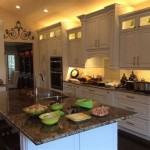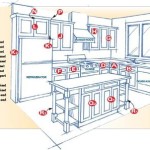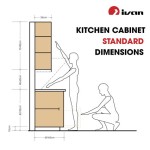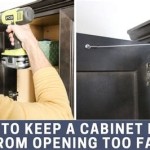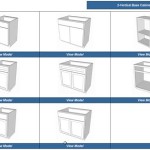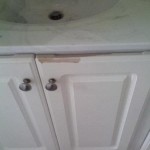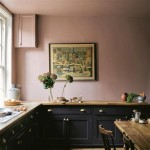Best Wood for Painted Kitchen Cabinets: A Comprehensive Guide
Selecting the right wood for painted kitchen cabinets is a critical decision influencing the longevity, aesthetics, and overall value of a kitchen renovation or new construction project. The choice extends beyond mere visual preference, encompassing factors like durability, paint adhesion, cost-effectiveness, and resistance to moisture and warping. Understanding the characteristics of various wood species and engineered wood products is essential for making an informed decision that balances budget constraints with desired performance and appearance.
The primary goal of painting kitchen cabinets is to achieve a smooth, uniform finish that resists chipping, peeling, and yellowing over time. The substrate wood must provide a stable and consistent surface for the paint to adhere to. Certain wood types, due to their inherent grain patterns, density, and resin content, are better suited for accepting and retaining paint than others. The selection process involves considering these factors in light of the intended design style, the expected level of use, and the environmental conditions within the kitchen.
Understanding Key Wood Properties for Painted Cabinets
The suitability of a wood species for painted kitchen cabinets hinges on several key properties that affect both the painting process and the cabinet's long-term performance. These properties include grain pattern, density, hardness, stability, and paint adhesion.
Grain Pattern: The grain pattern of wood significantly impacts the final appearance of painted cabinets. Woods with pronounced, open grains, like oak, tend to show the grain texture even after being painted. While some homeowners appreciate this textured look, others prefer a smoother, less textured surface achievable with woods like maple or birch, which have finer, closed grains. Choosing a wood with a tighter grain will result in a smoother painted surface, potentially requiring less filling and sanding during preparation.
Density and Hardness: Density and hardness contribute to the cabinet's overall durability and resistance to dents and scratches. Harder woods, such as maple and birch, are more resistant to impact and wear than softer woods like pine. However, softer woods can still be used effectively if properly primed and protected with a durable paint finish. The expected level of kitchen activity and the likelihood of accidental impacts should be considered when evaluating wood hardness.
Stability: Stability refers to the wood's resistance to warping, shrinking, and swelling in response to changes in humidity and temperature. Kitchens are often exposed to fluctuating humidity levels, making stability a crucial factor. Woods that are prone to significant movement can cause paint to crack and peel over time. Kiln-dried hardwoods are generally more stable than green or improperly seasoned lumber. Engineered wood products like MDF (Medium-Density Fiberboard) and plywood offer excellent dimensional stability, making them popular choices for cabinet components.
Paint Adhesion: The wood's surface properties influence how well paint adheres. Some woods, particularly those with high resin or oil content, require special primers or surface preparation to ensure proper paint adhesion. Woods with smoother surfaces and minimal grain raise tend to accept paint more readily. Proper sanding and priming are essential steps in preparing any wood surface for painting, regardless of the species.
Popular Wood Choices for Painted Kitchen Cabinets
Several wood species and engineered wood products are commonly used for painted kitchen cabinets, each with its own set of advantages and disadvantages.
Maple: Maple is a hardwood favored for its fine, closed grain, which provides a smooth surface for paint. It is also a durable and relatively stable wood, making it a good choice for cabinets that will withstand heavy use. Maple is readily available and typically falls within a moderate price range, making it an accessible option for many homeowners. The subtle grain pattern allows for a clean, contemporary look when painted. Maple's hardness also makes it resistant to dents and scratches, enhancing the longevity of the cabinets.
Birch: Similar to maple, birch also has a fine grain and smooth surface, making it an excellent choice for painted cabinets. It is generally less expensive than maple, making it a budget-friendly alternative. However, birch may be slightly softer than maple and can be more prone to dents and scratches. Birch plywood is a commonly used material for cabinet boxes due to its stability and smooth paintable surface. While birch shares many characteristics with maple, its slightly softer nature should be considered in high-traffic kitchens.
Poplar: Poplar is a softwood that is often used for paint-grade cabinets due to its affordability and ease of machining. It has a relatively smooth surface and accepts paint well, but it is softer than maple or birch and more susceptible to dents and scratches. Poplar is often used for cabinet frames and door stiles, while more durable materials are used for door panels and drawer fronts. Its lower cost makes it an attractive option for budget-conscious projects, but its susceptibility to damage requires careful consideration of placement and usage.
Oak: Oak is a hardwood known for its prominent grain pattern. While it can be painted, the grain texture will remain visible, which may not be desirable for those seeking a smooth, modern look. Oak is a durable and strong wood, making it suitable for cabinets that need to withstand heavy use. However, the open grain requires more filling and sanding to achieve a smooth painted finish, increasing labor costs. Oak is often used for traditional or rustic kitchen designs where the grain texture is considered an asset. The visible grain can add character and depth to painted cabinets, but it's crucial to understand the aesthetic implications before choosing oak.
Medium-Density Fiberboard (MDF): MDF is an engineered wood product made from wood fibers and resin. It has a very smooth, consistent surface and excellent dimensional stability, making it an ideal substrate for paint. MDF is also relatively inexpensive, making it a popular choice for cabinet doors and drawer fronts. However, MDF is not as strong or durable as solid wood and can be susceptible to water damage. It is typically used for cabinet components that are not subject to heavy loads or moisture exposure. MDF's smooth surface minimizes the need for extensive sanding and filling, resulting in a high-quality painted finish. However, edge sealing is crucial to prevent moisture absorption and swelling.
Plywood: Plywood is another engineered wood product made from layers of wood veneer glued together. It offers good strength and stability and is often used for cabinet boxes and sides. Plywood can be painted, but the surface may require more preparation than MDF to achieve a smooth finish. The veneer layers can sometimes cause grain raise when painted, requiring additional sanding. High-quality plywood with a smooth veneer surface is preferred for painted applications. Plywood's strength and stability make it a reliable choice for cabinet construction, particularly in areas prone to moisture fluctuations.
Factors Influencing Wood Selection for Painted Cabinets
Beyond the inherent properties of the wood, several other factors influence the selection process. These include budget constraints, design style, and the desired level of maintenance.
Budget: The cost of different wood species and engineered wood products varies significantly. Maple and birch typically fall within a moderate price range, while oak and cherry are generally more expensive. Poplar and MDF are often the most affordable options. Establishing a budget early in the project will help narrow down the wood choices to those that are financially feasible. Consider the long-term cost of ownership, including the potential for repairs or replacements, when evaluating different wood options. A slightly more expensive, durable wood might be a better investment in the long run.
Design Style: The desired design style of the kitchen can also influence the wood selection. For a modern or contemporary kitchen, woods with fine grains like maple or MDF may be preferred for their smooth, paintable surfaces. For a more traditional or rustic kitchen, oak or other woods with prominent grain patterns may be more appropriate. The wood's texture and color can contribute to the overall aesthetic of the kitchen. Consider how the painted cabinets will complement other design elements, such as countertops, flooring, and hardware.
Maintenance: The level of maintenance required for painted cabinets can also influence the wood selection. Harder woods like maple are more resistant to scratches and dents, requiring less frequent touch-ups. Cabinets made from MDF or plywood may require more careful handling to prevent damage. The type of paint and finish used can also affect the maintenance requirements. A durable, easy-to-clean paint finish will help protect the cabinets from stains and spills. Regular cleaning with a mild detergent and water is essential for maintaining the appearance of painted cabinets.
Choosing the right wood involves considering these factors comprehensively to ensure the final result aligns with the desired aesthetic, functional requirements, and budget constraints. Careful planning and thoughtful selection will contribute to the creation of beautiful and durable painted kitchen cabinets that enhance the value and enjoyment of the home.

Selecting The Best Wood For Kitchen Cabinets Thomas

The Best Wood Species For Painted Cabinets

Best Wood For Kitchen Cabinets Cabinet Materials Custom

How To Paint Kitchen Cabinets Best Color Ideas Cost

Painted Wood Cabinets Vs Stained A Questionnaire Kylie M Interiors
Ultimate Guide To Wood Kitchen Cabinets Vevano

Painted Vs Stained Cabinets Which Fits Your Style Best

Farmhouse Check In A What We Chose Edition Stained Wood Or Painted Cabinets Emily Henderson

Budget Kitchen Renovation With Diy Shaker Painted Cabinets I

Tips And Ideas How To Update Oak Or Wood Cabinets Paint Stain More
Related Posts

